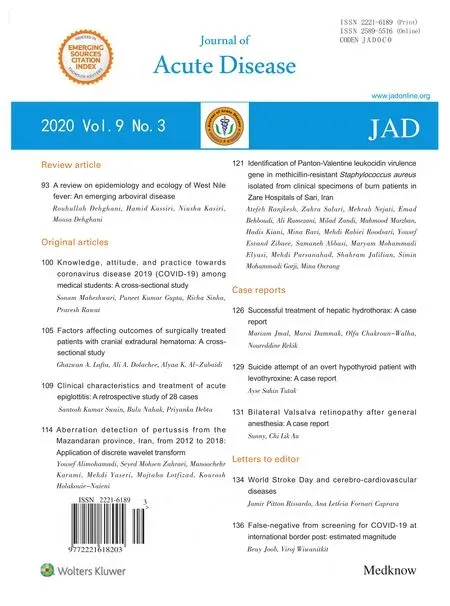World Stroke Day and cerebro-cardiovascular diseases
Jamir Pitton Rissardo, Ana Letícia Fornari CapraraNeurology Department, Federal University of Santa Maria, Roraima Santa Maria, Brazil
2Medicine Department, Federal University of Santa Maria, Roraima Santa Maria, Brazil
We read the article entitled ‘‘Stroke with persisting falsenegative diffusion-weighted imagings: A case report’’ on the esteemed Journal of Acute Disease with great interest. The author reported a case of an elderly male individual with acute onset of dysarthria and right lower paresis. Brain MRI images after 6 and 19 h were normal; only after 180 h the diffusion restriction in the medullary region was observed. This study revealed the importance of the neurological examination associated with the repetition of imaging studies when the diagnosis is unclear[1].
Herein, we would like to raise awareness about stroke, an important cause of mortality and morbidity. October 29 is considered World Stroke Day. This date was established in 2004 at the World Stroke Congress in Vancouver, Canada. But, only in 2006 with the direction of Vladimir Hachinski who is a Canadian clinical neuroscientist and researcher based at the Schulich School of Medicine and Dentistry at Western University, the date was included in the World Stroke Proclamation. In the same period, the International Stroke Society and the World Stroke Federation combined to form the World Stroke Organization, and since that merge, the management of World Stroke Day is charged by World Stroke Organization[2].
Stroke is among the three most common causes of disability and mortality in the world. Brazil has one of the highest Framingham risk scores of the Latin American countries; women with 11.8% (moderate risk) and 24.7% for men (high risk)[3]. However, the knowledge about stroke is still scarce, even in a population with levels of formal education above the national average and in a city where the annual promotion of Stroke Awareness Campaigns have taken place for almost a decade[4].
An original article from India done by Murthy et al. evaluated the level of awareness of accredited social health activists. Their results showed that the individuals studied do not have a meaningful knowledge about the epidemiology, first aid support, or even the main risk factors[5]. It is important to discuss this point because a significant percentage of the population still believe in myths. Only some individuals independent of their formal knowledge but dependent on the information source like friends and relatives appeared to know how to proceed in these cases. However, it is interesting that the articles about stroke knowledge evaluation already published revealed a systematic failure in those points[4]. Therefore, we believe that stroke awareness should be continuously done with special care for the signal’s recognition due to worse scores when compared to others.
One interesting fact about stroke and acute myocardial infarction is their association with mood disorders. Cho et al. recently published a population-based study with more than two million Korean adults, where their aim was to assess the relationship of socioeconomic status and depression with the incidences of acute myocardial infarction and stroke. Their results showed that a low socioeconomic status or depression is associated with increased risks of myocardial infarction and stroke incidence. In addition, another interesting fact was that when these two variables are together, the risk significantly increases for acute myocardial infarction (HR, 1.47; 95%CI, 1.36-1.60) and stroke (HR, 1.37; 95%CI, 1.30-1.44). Thus, they recommend that socioeconomic status and depression should be evaluated in clinical practice when cardiovascular risk is being assessed[6].
Conflict of interest statement
The authors report no conflict of interest.
Authors’ contribution
J.P.R. carried out the literature search, review, and manuscript preparation. A.L.F.C. performed the literature search and manuscript editing. All authors read and approved the final manuscript.
 Journal of Acute Disease2020年3期
Journal of Acute Disease2020年3期
- Journal of Acute Disease的其它文章
- Bilateral Valsalva retinopathy after general anesthesia: A case report
- Suicide attempt of an overt hypothyroid patient with levothyroxine: A case report
- Successful treatment of hepatic hydrothorax: A case report
- Identification of Panton-Valentine leukocidin virulence gene in methicillinresistant Staphylococcus aureus isolated from clinical specimens of burn patients in Zare Hospitals of Sari, Iran
- Aberration detection of pertussis from the Mazandaran province, Iran, from 2012 to 2018: Application of discrete wavelet transform
- Clinical characteristics and treatment of acute epiglottitis: A retrospective study of 28 cases
